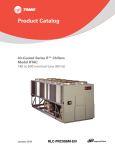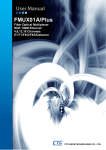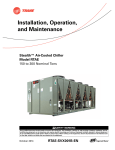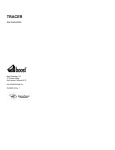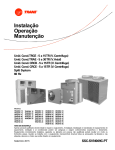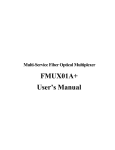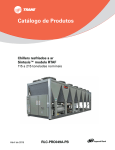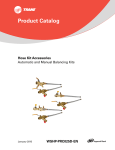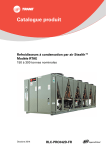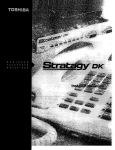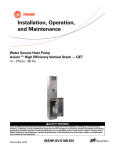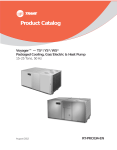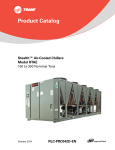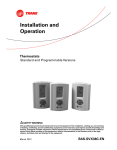Download Trane Series R Helical Rotary Model RTAC Catalogue
Transcript
Product Catalog Air-Cooled Series R™ Chillers Model RTAC 120 to 400 nominal tons (50 Hz) January 2015 RLC-PRC039B-EN Introduction Like its chillers,Trane wants its relationships with customers to last.Trane is interested in maintaining long term, loyal relationships.This perspective means the point in time that a customer purchases a chiller is the beginning of a relationship, not the end.Your business is important, but your satisfaction is paramount. The RTAC offers high reliability coupled with proven Series R performance. The Series R Model RTAC is an industrial grade design built for both the industrial and commercial markets. It is ideal for schools, hospitals, retailers, office buildings, Internet service providers and manufacturing facilities. Copyright This document and the information in it are the property ofTrane, and may not be used or reproduced in whole or in part without written permission.Trane reserves the right to revise this publication at any time, and to make changes to its content without obligation to notify any person of such revision or change. Trademarks All trademarks referenced in this document are the trademarks of their respective owners. Revision History RLC-PRC039B-EN (15 Jan 2015) The following points describe the changes to this revision on the manual: • Updated electrical data and customer wiring information • Rapid RestartTest • Add seismic isolator option • Added optional tarp information © 2015Trane All rights reserved RLC-PRC039B-EN Table of Contents Introduction . . . . . . . . . . . . . . . . . . . . . . . . . . . . . . . . . . . . . . . . . . . . . . . . . . . . . . 2 Table of Contents . . . . . . . . . . . . . . . . . . . . . . . . . . . . . . . . . . . . . . . . . . . . . . . . . . 3 Features and Benefits . . . . . . . . . . . . . . . . . . . . . . . . . . . . . . . . . . . . . . . . . . . . . . 4 Application Considerations . . . . . . . . . . . . . . . . . . . . . . . . . . . . . . . . . . . . . . . . . . 7 Model Number Descriptions . . . . . . . . . . . . . . . . . . . . . . . . . . . . . . . . . . . . . . . . 13 General Data . . . . . . . . . . . . . . . . . . . . . . . . . . . . . . . . . . . . . . . . . . . . . . . . . . . 14 Performance Data . . . . . . . . . . . . . . . . . . . . . . . . . . . . . . . . . . . . . . . . . . . . . . 18 Controls . . . . . . . . . . . . . . . . . . . . . . . . . . . . . . . . . . . . . . . . . . . . . . . . . . . . . . . . 25 Electrical Data . . . . . . . . . . . . . . . . . . . . . . . . . . . . . . . . . . . . . . . . . . . . . . . . . . . . 28 Electrical Connection . . . . . . . . . . . . . . . . . . . . . . . . . . . . . . . . . . . . . . . . . . 34 Dimensions . . . . . . . . . . . . . . . . . . . . . . . . . . . . . . . . . . . . . . . . . . . . . . . . . . . . . . 42 Weights . . . . . . . . . . . . . . . . . . . . . . . . . . . . . . . . . . . . . . . . . . . . . . . . . . . . . . . . . 51 Mechanical Specifications . . . . . . . . . . . . . . . . . . . . . . . . . . . . . . . . . . . . . . . . . . 52 Options . . . . . . . . . . . . . . . . . . . . . . . . . . . . . . . . . . . . . . . . . . . . . . . . . . . . . . . . . 53 RLC-PRC039B-EN 3 Features and Benefits World Class Energy Efficiency The importance of energy efficiency cannot be understated. Fortunately, ASHRAE has created a guideline emphasizing its importance. Nonetheless, energy is often dismissed as an operational cost over which the owner has little control.That perception results in missed opportunities for energy efficiency, reduced utility bills, and higher profits. Lower utility bills directly affect profitability. Every dollar saved in energy goes directly to the bottom line.Trane's RTAC is one way to maximize your profits. ASHRAE Standard 90.1 and Executive Order AllTrane air-cooled chillers meet the new efficiency levels mandated by ASHRAE Standard 90.1. This new standard requires higher efficiencies than past technologies can deliver.The US Federal Government has adopted standard 90.1 and, in some cases, requires even higher efficiencies. Federal Executive Order mandates energy consuming devices procured must be in the top 25% of their class. In the case of chillers, that product standard is ASHRAE 90.1.Trane's RTAC meets and exceeds the efficiency requirements of 90.1, while the high and extra efficiency RTAC can meet the "stretch goals" of Executive Order. Precise Capacity Control Trane's patented unloading system allows the compressor to modulate infinitely and exactly match building loads. At the same time chilled water temperatures will be maintained within +/- 1/2ºF (0.28°C) of setpoint. Screw or scroll chillers with stepped capacity control do well to maintain chilled water temperatures within 2ºF (1.1°C) of setpoint. Stepped control also results in over cooling because rarely does the capacity of the machine match the building load.The result can be 10% higher energy bills.Trane's RTAC optimizes the part load performance of your machine for energy efficiency, precise control for process applications, and your personal comfort regardless of the weather outside. Excellent Reliability A buildings environment is expected to be comfortable. When it is, no one says a word. If it's not… that's a different story.The same is true with chillers. No one ever talks about chillers, yet alone compressors, until they fail, and tenants are uncomfortable and productivity is lost.Trane's helical rotary compressors have been designed and built to stay running when you need them. Fewer moving parts Trane's helical rotary compressors have only two major rotating parts: the male and female rotor. A reciprocating compressor can have more than 15 times that number of critical parts. Multiples of pistons, valves, crankshafts, and connecting rods in a reciprocating unit all represent different failure paths for the compressor. In fact, reciprocating compressors can easily have a failure rate four times of a helical rotor. Combine that with two to three reciprocating compressors for each helical rotary compressor on chillers of equal tonnage, and statistics tell you it's a matter of time before you lose a reciprocating compressor. Robust components Helical rotary compressors are precisely machined using state of the art processes from solid metal bar stock.Tolerances are maintained within a micron or less than a tenth of the diameter of a human hair.The resulting compressor is a robust yet highly sophisticated assembly capable of ingesting liquid refrigerant without risk of damage. 4 RLC-PRC039B-EN Features and Benefits Condenser coils Trane's condenser coils are manufactured with the same philosophy as the compressors; they're built to last. Even though manufacturing processes have allowed thinner and thinner materials in their assembly, with obvious material and manufacturing savings,Trane's coil material did not change with the RTAC generation of air cooled chillers. Substantial condenser fins, that do not require additional coating in non-corrosive environments, contribute to the highest reliability standards for air-cooled chillers in the industry. Superior Control The Adaptive Control™ microprocessor system enhances the air-cooled Series R chiller by providing the very latest chiller control technology. With the Adaptive Control microprocessor, unnecessary service calls and unhappy tenants are avoided.The unit is designed not to trip or unnecessarily shut down. Only when theTracer™ chiller controllers have exhausted all possible corrective actions and the unit is still violating an operating limit will the chiller shut down. Controls on other equipment typically shut down the chiller, usually just when it is needed the most. For example: A typical five year old chiller with dirty coils might trip out on high pressure cutout on a 100°F (38°C) day in August. A hot day is just when comfort cooling is needed the most. In contrast, the air-cooled Series R chiller with an Adaptive Control microprocessor will stage fans on, modulate electronic expansion valves, and modulate slide valve positions as the chiller approaches a high pressure cutout, thereby keeping the chiller online when you need it the most. Simple Installation RLC-PRC039B-EN • Factory Installed Flow Switch. Installed in the optimum location in the piping for reduced chiller installation cost and superior flow sensing, reducing the potential for nuisance trips. • Close Spacing Installation.The air-cooled Series R™ Chiller has the tightest recommended side clearance in the industry, four feet for maximum performance. In situations where equipment must be installed with less clearance than recommended, which frequently occurs in retrofit applications, restricted airflow is common. Conventional chillers may not work at all. However, the air-cooled Series R chiller with Adaptive Control™ microprocessor will make as much chilled water as possible given the actual installed conditions, stay on line during unforeseen abnormal conditions, and optimize the unit performance. Consult yourTrane sales engineer for more details. • Factory Testing Means Trouble Free Startup. All air-cooled Series R chillers are given a complete functional test at the factory.This computer based test program completely checks the sensors, wiring, electrical components, microprocessor function, communication capability, expansion valve performance and fans. In addition, each compressor is run and tested to verify capacity and efficiency. Where applicable, each unit is factory preset to the customer's design conditions; an example would be leaving liquid temperature setpoint.The result of this test program is that the chiller arrives at the job site fully tested and ready for operation. • Factory Installed and Tested Controls/Options Speed Installation. All Series R chiller options, including main power supply disconnect, low ambient control, ambient temperature sensor, low ambient lockout, communication interface and ice making controls, are factory installed and tested. Some manufacturers send accessories in pieces to be field installed. With Trane, the customer saves on installation expense and has assurance that ALL chiller controls/ options have been tested and will function as intended. 5 Features and Benefits Unit Performance Testing The AHRI Certification Program has had a certification program covering air-cooled water chillers for many years. With this in mind, customers may ask, "Do I need to factory performance test my chiller?" Trane began promoting factory performance tests for water-cooled water chillers in 1984 for the same reasons it is valid today for air-cooled water chillers, to show we stand behind the products we design and build. The benefits of a performance test include verification of performance, prevention of operational problems, and assurance of a smooth startup. Only a performance test conducted in a laboratory or laboratory grade facility will confirm both performance and operation of a specific chiller. While most factory performance tests go smoothly, should problems occur,Trane personnel can quickly correct them and the chiller will ship as specified. Job site diagnosis, ordering of parts, and waiting for delivery of replacement components is significantly reduced. A factory performance test reduces startup time, thereby saving job site expense. A chiller that has been tested is operation and performance proven.This allows the installing contractor to concentrate on proper electrical wiring and water piping, and the service technicians to concentrate on proper refrigerant charge, safeties diagnosis and initial logging of the chiller. Means of obtaining full load on the chiller and proving its performance do not have to be determined by engineers or contractors, thus saving time.The certified test report documents performance for the unit as built. In addition, factory testing significantly reduces commissioning time and risk by reintroducing manufacturer responsibility, where its mitigation should reside. When a factory performance test is requested, the test can be conducted at the specified design conditions for all packaged chillers.The test facility has the capability to control ambient test conditions to assure our customers that our chillers will perform as predicted. Rapid Restart™ testing is also available to demonstrate the chiller’s rapid restart capabilities for disaster relief.While the chiller is operating at customer specified full load conditions, power to the chiller is cut and the customer can witness how quickly the chiller will return to full load. For more information on test performance testing, see brochure RL-SLB012-EN. 6 RLC-PRC039B-EN Application Considerations Important Certain application constraints should be considered when sizing, selecting and installingTrane aircooled Series R chillers. Unit and system reliability is often dependent upon proper and complete compliance with these considerations.When the application varies from the guidelines presented, it should be reviewed with your localTrane sales engineer. Unit Sizing Unit capacities are listed in the performance data section. Intentionally over sizing a unit to assure adequate capacity is not recommended. Erratic system operation and excessive compressor cycling are often a direct result of an oversized chiller. In addition, an oversized unit is usually more expensive to purchase, install, and operate. If over sizing is desired, consider using multiple units. Water Treatment Dirt, scale, products of corrosion and other foreign material will adversely affect heat transfer between the water and system components. Foreign matter in the chilled water system can also increase pressure drop and consequently, reduce water flow. Proper water treatment must be determined locally, depending on the type of system and local water characteristics. Neither salt nor brackish water is recommended for use inTrane air-cooled Series R chillers. Use of either will lead to a shortened life to an indeterminable degree.TheTrane Company encourages the employment of a reputable water treatment specialist, familiar with local water conditions, to assist in this determination and in the establishment of a proper water treatment program. Effect Of Altitude On Capacity Air-cooled Series R chiller capacities given in the performance data tables are for use at sea level. At elevations substantially above sea level, the decreased air density will reduce condenser capacity and, therefore, unit capacity and efficiency. Ambient Limitations Trane air-cooled Series R chillers are designed for year round operation over a range of ambient temperatures.The Model RTAC chiller will operate as standard in ambient temperatures of 25°F to 115°F (-4°C to 46°C). With the low ambient option, these units will operate down to 0°F (-18°C). If an ambient temperature as high as 125°F (51°C) is the basis for design, the high ambient option will permit the chiller to run without going into a limiting condition. For installations in areas with large ambient differences, the wide ambient option will allow the chiller to perform uninhibited from 0°F to 125°F (-18°C to 51°C). Water Flow Limits The minimum and maximum water flow rates are given in the General Data tables. Evaporator flow rates below the tabulated values will result in laminar flow causing freeze up problems, scaling, stratification and poor control. Flow rates exceeding those listed may result in excessive tube erosion. Note: Flow rates in General Data tables are for water only.They do not include glycol. Leaving Water Temperature Limits Trane air-cooled Series R chillers have three distinct leaving water categories: standard, low temperature, and ice making.The standard leaving solution temperature range is 40 to 65°F (4.4 to 15.6°C). Low temperature machines produce leaving liquid temperatures less than 40°F (4.4°C). Since liquid supply temperature setpoints less than 40°F (4.4°C) result in suction temperatures at or below the freezing point of water, a glycol solution is required for all low temperature machines. Ice making machines have a leaving liquid temperature range of 20 to 60°F (-6.7 to 15.6°C). Ice making controls include dual setpoint controls and safeties for ice making and standard cooling capabilities. Consult your localTrane sales engineer for applications or selections involving low RLC-PRC039B-EN 7 Application Considerations temperature or ice making machines.The maximum water temperature that can be circulated through an evaporator when the unit is not operating is 108°F (42°C). Flow Rates Out of Range Many process cooling jobs require flow rates that cannot be met with the minimum and maximum published values for the Model RTAC evaporator. A simple piping change can alleviate this problem. For example: A plastic injection molding process requires 80 gpm (5.1 l/s) of 50°F (10°C) water and returns that water at 60°F (15.6°C).The selected chiller can operate at these temperatures, but has a minimum flow rate of 120 gpm (7.6 l/s).The system layout in Figure A1 can satisfy the process. Figure 1. Flow rate out of range system layout Flow Control Trane requires the chilled water flow control in conjunction with the Air-Cooled Series R Chiller to be done by the chiller.This will allow the chiller to protect itself in potentially harmful conditions. Supply Water Temperature Drop The performance data for theTrane air-cooled Series R chiller is based on a chilled water temperature drop of 10°F (5.6°C). Chilled water temperature drops from 6 to 18°F (3.3 to 10°C) may be used as long as minimum and maximum water temperatures and flow rates are not violated. Temperature drops outside this range are beyond the optimum range for control and may adversely affect the microcomputer's ability to maintain an acceptable supply water temperature range. Further, temperature drops of less than 6°F (3.3°C) may result in inadequate refrigerant superheat. Sufficient superheat is always a primary concern in any refrigerant system and is especially important in a package chiller where the evaporator is closely coupled to the compressor.When temperature drops are less than 6°F (3.3°C), an evaporator runaround loop may be required. Leaving Water Temperature Out of Range Many process cooling jobs require temperature ranges that cannot be met with the minimum and maximum published values for the Model RTAC evaporator. A simple piping change can alleviate this problem. For example: A laboratory load requires 120 gpm (7.6 l/s) of water entering the process at 85°F (29.4°C) and returning at 95°F (35°C).The accuracy required is better than the cooling tower can give.The selected chiller has adequate capacity, but a maximum leaving chilled water temperature of 60°F (15.6°C). In Figure A2, both the chiller and process flow rates are equal.This is not necessary. For example, if the chiller had a higher flow rate, there would simply be more water bypassing and mixing with warm water. 8 RLC-PRC039B-EN Application Considerations Figure 2. Temperature out of range system layout Variable Flow in the Evaporator An attractive chilled water system option may be a variable primary flow (VPF) system. VPF systems present building owners with several cost saving benefits that are directly related to the pumps.The most obvious cost savings result from eliminating the secondary distribution pump, which in turn avoids the expense incurred with the associated piping connections (material, labor), electrical service, and variable frequency drive. Building owners often cite pump related energy savings as the reason that prompted them to install a VPF system. The evaporator on the Model RTAC can withstand up to 50 percent water flow reduction as long as this flow is equal to or above the minimum flow rate requirements.The microprocessor and capacity control algorithms are designed to handle a maximum of 10% change in water flow rate per minute in order to maintain ± 0.5°F (0.28°C) leaving evaporator temperature control. For applications in which system energy savings is most important and tight temperature control is classified as +/- 2°F (1.1°C), up to 30 percent changes in flow per minute are possible. With the help of a software analysis tool such as System Analyzer™, DOE-2 orTRACE™, you can determine whether the anticipated energy savings justify the use of variable primary flow in a particular application. It may also be easier to apply variable primary flow in an existing chilled water plant. Unlike the "decoupled" system design, the bypass can be positioned at various points in the chilled water loop and an additional pump is unnecessary. Series Chiller Arrangements Another energy saving strategy is to design the system around chillers arranged in series.The actual savings possible with such strategies depends on the application dynamics and should be researched by consulting yourTrane Systems Solutions Representative and applying an analysis tool from theTrace software family. It is possible to operate a pair of chillers more efficiently in a series chiller arrangement than in a parallel arrangement. It is also possible to achieve higher entering to leaving chiller differentials, which may, in turn, provide the opportunity for lower chilled water design temperature, lower design flow, and resulting installation and operational cost savings.TheTrane screw compressor also has excellent capabilities for “lift,” which affords an opportunity for “lift,” which affords an opportunity for savings on the evaporator water loop. Series chiller arrangements can be controlled in several ways. Figure A3 shows a strategy where each chiller is trying to achieve the system design set point. If the cooling load is less than 50 percent of the systems capabilities, either chiller can fulfill the demand. As system loads increase, the Chiller 2 becomes preferentially loaded as it attempts to meet the leaving chilled water setpoint. Chiller 1 will finish cooling the leaving water from Chiller 2 down to the system design setpoint. RLC-PRC039B-EN 9 Application Considerations Staggering the chiller set points is another control technique that works well for preferentially loading Chiller 1. If the cooling load is less than 50 percent of the system capacity, Chiller 1 would be able to satisfy the entire call for cooling. As system loads increase, Chiller 2 is started to meet any portion of the load that Chiller 1 can not meet. Figure 3. Typical series chiller arrangement Typical Water Piping All building water piping must be flushed prior to making the final connections to the chiller.To reduce heat loss and prevent condensation, insulation should be installed. Expansion tanks are also usually required so that chilled water volume changes can be accommodated. Short Water Loops The proper location of the temperature control sensor is in the supply (outlet) water connection or pipe.This location allows the building to act as a buffer and assures a slowly changing return water temperature. If there is not a sufficient volume of water in the system to provide an adequate buffer, temperature control can be lost, resulting in erratic system operation and excessive compressor cycling. A short water loop has the same effect as attempting to control from the building return water.Typically, a two minute water loop is sufficient to prevent problems.Therefore, as a guideline, ensure the volume of water in the evaporator loop equals or exceeds two times the evaporator flow rate in gallons per minute. For a rapidly changing load profile, the amount of volume should be increased.To prevent the effect of a short water loop, the following items should be given careful consideration: A storage tank or larger header pipe to increase the volume of water in the system and, therefore, reduce the rate of change of the return water temperature. ApplicationsTypes 10 • Comfort cooling. • Industrial process cooling. • Ice/thermal storage. • Low temperature process cooling. RLC-PRC039B-EN Application Considerations Typical Unit Installation Outdoor HVAC equipment must be located to minimize noise and vibration transmission to the occupied spaces of the building structure it serves. If the equipment must be located in close proximity to a building, it could be placed next to an unoccupied space such as a storage room, mechanical room, etc. It is not recommended to locate the equipment near occupied, sound sensitive areas of the building or near windows. Locating the equipment away from structures will also prevent sound reflection, which can increase levels at property lines, or other sensitive points. When physically isolating the unit from structures, it is a good idea to not use rigid supports, and to eliminate any metal-to-metal or hard material contact, when possible.This includes replacing spring or metal weave isolation with elastomeric isolators. Figure A4 illustrates isolation recommendations for the RTAC. For chiller sound ratings, installation tips and considerations on chiller location, pipe isolation, etc., refer to theTrane Air-Cooled Series R Chillers Sound Data and Application Guide for Noise Sensitive Installations. System Options - Ice Storage Trane air-cooled Series R Chillers are well suited for ice production. An air-cooled machine typically switches to ice production at night.Two things happen under this assumption. First, the leaving brine temperature from the evaporator is lowered to around 22 to 24°F (-5.5 to -4.4°C). Second, the ambient temperature has typically dropped about 15 to 20°F (8.3 to 11°C) from the peak daytime ambient.This effectively places a lift on the compressors that is similar to daytime running conditions.The chiller can operate in lower ambient at night and successfully produce ice to supplement the next day's cooling demands. The Model RTAC produces ice by supplying ice storage tanks with a constant supply of glycol solution. Air-cooled chillers selected for these lower leaving fluid temperatures are also selected for efficient production of chilled fluid at nominal comfort cooling conditions.The ability ofTrane chillers to serve “double duty” in ice production and comfort cooling greatly reduces the capital cost of ice storage systems. When cooling is required, ice chilled glycol is pumped from the ice storage tanks directly to the cooling coils. No expensive heat exchanger is required.The glycol loop is a sealed system, eliminating expensive annual chemical treatment costs.The air-cooled chiller is also available for comfort cooling duty at nominal cooling conditions and efficiencies.The modular concept of glycol ice storage systems and the proven simplicity ofTraneTracer controllers allow the successful blend of reliability and energy saving performance in any ice storage application. The ice storage system is operated in six different modes: each optimized for the utility cost of the hour. 1. Provide comfort cooling with chiller 2. Provide comfort cooling with ice 3. Provide comfort cooling with ice and chiller 4. Freeze ice storage 5. Freeze ice storage when comfort cooling is required 6. Off Tracer optimization software controls operation of the required equipment and accessories to easily transition from one mode of operation to another. For example: Even with ice storage systems there are numerous hours when ice is neither produced or consumed, but saved. In this mode the chiller is the sole source of cooling. For example, to cool the building after all ice is produced but before high electrical demand charges take effect,Tracer sets the air-cooled chiller leaving fluid setpoint to its most efficient setting and starts the chiller, chiller pump, and load pump. RLC-PRC039B-EN 11 Application Considerations When electrical demand is high, the ice pump is started and the chiller is either demand limited or shut down completely.Tracer controls have the intelligence to optimally balance the contribution of ice and chiller in meeting the cooling load. The capacity of the chiller plant is extended by operating the chiller and ice in tandem.Tracer rations the ice, augmenting chiller capacity while reducing cooling costs.When ice is produced,Tracer will lower the air-cooled chiller leaving fluid setpoint and start the chiller, ice and chiller pumps, and other accessories. Any incidental loads that persist while producing ice can be addressed by starting the load pump and drawing spent cooling fluid from the ice storage tanks. For specific information on ice storage applications, contact your localTrane sales office. 12 RLC-PRC039B-EN Model Number Descriptions Digits 1, 2 - Unit Model Digit 16 - Evaporator Configuration Digit 27 - Electrical Protection Options 0 5 6 Digit 4 - Development Sequence N P Q R C Digit 17 - Condenser Application RT = Rotary chiller Digit 3 - Unit Type A = = Air-cooled Development sequence Digits 5, 6 & 7 - Nominal Capacity 120 130 140 155 170 185 200 250 275 300 350 375 400 = = = = = = = = = = = = = 120 Nominal tons 130 Nominal tons 140 Nominal tons 155 Nominal tons 170 Nominal tons 185 Nominal tons 200 Nominal tons 250 Nominal tons 275 Nominal tons 300 Nominal tons 350 Nominal tons 375 Nominal tons 400 Nominal tons Digit 8 - Unit Voltage D = 400/50/3 Digit 9 - Manufacturing Location U = Water Chiller Business Unit, Pueblo, CO USA Digits 10, 11 - Design Sequence XX = Factory Input N H L W = = = = = = = = 2 pass, 0.75” insulation 3 pass, 0.75” insulation 2 pass, 1.25” insulation 3 pass, 1.25” insulation Standard ambient (25-115°F) High ambient (25-125°F) Low ambient (0-115°F) Wide ambient (0-125°F) Digit 18 - Condenser Fin Material 1 2 4 = = = Standard aluminum slit fins Copper fins CompleteCoat™ epoxy coated fins = No convenience outlet Digit 30 - Service Valves 1 = With suction service valves 1 = X Y = = Across-the-line Wye-delta closed transition Digit 21 - Incoming Power Line Connection 1 2 = Single point power connection = Dual point power connection = = = Terminal block connection Non-fused disconnect switch(es) Circuit breaker(s) ) D ASME pressure vessel code Canadian code Australian code Chinese code N Digit 20 - Compressor Motor Starter Type N U S R = = = = Digit 29 - Control Panel Accessories = Digit 23 - Unit Operator Interface A C D L = 0 Digit 13 - Agency Listing Digit 14 - Pressure Vessel Code U Factory installed flow switch water Factory installed flow switch glycol STD fans withTEAO motors Low noise fans T D C No agency listing C/UL listing Seismic rated - IBC and OSHPD C/UL listed and seismic rated = T = W = N H A = = = = Digit 28 - Flow Switch T Digit 31 - Compressor Sound Attenuation Option Digit 22 - Power Line Connection Type Standard efficiency/performance High efficiency/performance Extra efficiency/performance No short circuit rating Default short circuit rating High amp short circuit rating Digit 19 - Condenser Fan/Motor Configuration Digit 12 - Unit Basic Configuration = = = = = = = DynaView operator interface Digit 24 - Remote Operator Interface N C B L = = = = No remote interface Tracer™ Comm 3 interface BACnet® interface LonTalk® compatible (LCI-C) interface No compressor sound attenuation Factory installed compressor sound attenuation Digit 32 - Appearance Options N A C = = = No appearance options Architectural louvered panels Half louvers Digit 33 - Installation Accessories N F R G E = = = = = S = No installation accessories Flange kit for water connections Neoprene in shear unit isolators Neoprene isolators and flange kit Seismic elastomeric isolation pads Seismic spring isolators Digit 34 - Factory Testing Options 0 C = = C = E = Standard functional test Customer-witnessed performance test with report Customer-witnessed performance test plus Rapid Restart test Non-witnessed performance test with report Digit 15 - Evaporator Application Digit 25 - Control Input Accessories/Options Digit 35 — Control, Label & Literature F G N R = = C E F C B = = = = Standard (40-60 F) leaving temp Low (Less than 40 F) leaving temp No remote inputs Ext. evaporator leaving water setpoint Ext. current limit setpoint Ext. leaving water and current limit setpoint Digit 26 - Control Output Accessories/Options N A C D RLC-PRC039B-EN = = = = No output options Alarm relay outputs Ice making I/O Alarm relay outputs and ice making I/O = = = Spanish English French Digit 36 — Special Order X S = = Standard unit configuration Unit has special order feature Digit 37 — Safety Devices N = Standard 13 General Data Table 1. 50 Hz standard efficiency — I-P Size 140 155 170 185 200 Compressor 250 275 300 350 375 400 4 4 Screw Quantity # Nominal size@50Hz (tons) 2 70/70 2 85/70 2 85/85 2 100/85 2 3 3 3 4 100/100 70-70 / 100 85-85 / 100 100100/100 85-85/ 85-85 62 67 75 Evaporator 100-100/ 100-100/ 85-85 100-100 Flooded Water storage (gal) 29 32 34 36 40 56 79 83 Min flow (gpm) 193 214 202 217 241 265 309 339 351 381 404 Max flow (gpm) 709 785 741 796 883 970 1134 1243 1287 1396 1483 4 4 6 6 6 8 8 8 8 8 8 2 pass arrangement Water connection (NPS-in) 3 pass arrangement Min flow (gpm) 129 143 135 145 161 176 206 226 234 254 270 Max flow (gpm) 473 523 494 531 589 647 756 829 858 930 989 3.5 3.5 4 4 4 6 6 6 8 8 8 8 8 8 8 8 Water connection (NPS-in) Condenser Fin and tube Qty of coils # Coil length (in) 216/180 216/216 Coil height (in) 42 42 42 42 42 42 42 42 42 42 42 # 3 3 3 3 3 3 3 3 3 3 3 (fpf) 192 192 192 192 192 192 192 192 192 192 192 Quantity # 4/4 5/4 5/5 6/5 6/5 8/6 10/6 12/6 10/10 12/10 12/12 Diameter (in) 30 30 30 30 30 30 30 30 30 30 30 (cfm) 7918 7723 7567 7567 7567 7764 7566 7567 7567 7567 7567 Number of rows Fins per foot 4 4 4 4 4 8 156/156 180/156 180/180 216/180 216/216 156/108 180/108 216/108 180/180 Fan Direct drive propeller Air flow per fan Power per motor Fan speed (hp) 1.0 1.0 1.0 1.0 1.0 1.0 1.0 1.0 1.0 1.0 1.0 (rpm) 950 950 950 950 950 950 950 950 950 950 950 7461 7461 7461 7461 7461 7461 7461 7461 7461 7461 7461 Tip speed (Ft/min) General Unit HFC-134a # refrig ckts # 2 2 2 2 2 2 2 2 2 2 2 % min load % 15 15 15 15 15 15 15 15 15 15 15 415/415 460/460 2.3-2.3/ 2.1-2.1 2.3-2.3/ 2.3-2.3 Refrig charge (lb) 175/175 215/205 215/215 225/215 225/225 235/235 235/235 415/200 460/200 Oil charge (gal) 1.3/1.3 1.3/1.3 1.3/1.3 1.9/1.3 1.9/1.9 2.1-2.1/ 1.9 Min ambient-std (°F) 25 25 25 25 25 25 25 25 25 25 25 Min ambient-low (°F) 0 0 0 0 0 0 0 0 0 0 0 2.1-2.1/ 2.3-2.3/ 2.1-2.1/ 1.9 1.9 2.1-2.1 1. Data containing information on two circuits is shown as follows: ckt 1/ ckt 2. 2. Minimum start-up/operating ambient is based on a 5 mph wind across the condenser. 14 RLC-PRC039B-EN General Data Table 2. 50 Hz high efficiency — I-P Size 120 130 140 155 170 185 200 250 Compressor Quantity Nominal size@50Hz # 2 2 2 2 2 2 2 100/ 100 (tons) 60/60 70/60 70/70 85/70 85/85 100/ 85 300 (gal) 29 32 34 36 40 39 43 3 3 3 70-70 / 85-85 / 100100 100 100/100 Evaporator Water storage 275 350 375 400 4 4 Screw 4 85-85 / 85-85 100-100/ 100-100/ 85-85 100-100 Flooded 67 72 72 83 86 91 2 pass arrangement Min flow (gpm) 193 214 202 217 241 217 241 339 375 375 404 422 461 Max flow (gpm) 709 785 741 796 883 796 883 1243 1374 1374 1483 1548 1690 4 4 6 6 6 6 6 8 8 8 8 8 8 Water (NPS-in) connection 3 pass arrangement Min flow (gpm) 129 143 135 145 161 145 161 226 250 250 270 282 307 Max flow (gpm) 473 523 494 531 589 531 589 829 916 916 989 1032 1127 3.5 3.5 4 4 4 4 4 6 6 6 8 8 8 # 4 4 4 4 4 4 4 8 8 8 8 8 8 Coil length (in) 156/ 156 180/ 156 180/ 180 216/ 180 216/ 216 252/ 216 252/ 252 180/ 108 216/ 144 252/216 252/252 Coil height (in) 42 42 42 42 42 42 42 42 42 42 42 42 42 # 3 3 3 3 3 3 3 3 3 3 3 3 3 (fpf) 192 192 192 192 192 192 192 192 192 192 192 192 192 14/14 Water (NPS-in) connection Condenser Qty of coils Number of rows Fins per foot Fin and tube Fan 252/144 216/216 Direct drive propeller Quantity # 4/4 5/4 5/5 6/5 6/6 7/6 7/7 10/6 12/6 14/6 12/12 14/12 Diameter (in) 30 30 30 30 30 30 30 30 30 30 30 30 30 7558 7557 7557 7558 7559 7561 7943 7906 7557 7490 7559 Air flow per fan Power per motor Fan speed (cfm) 62484 68819 (hp) 1.0 1.0 1.0 1.0 1.0 1.0 1.0 1.0 1.0 1.0 1.0 1.0 1.0 (rpm) 950 950 950 950 950 950 950 950 950 950 950 950 950 7461 7461 7461 7461 7461 7461 7461 7461 7461 7461 7461 7461 7461 Tip speed (Ft/min) General Unit HFC-134a # refrig ckts # 2 2 2 2 2 2 2 2 2 2 2 2 2 % min load % 15 15 15 15 15 15 15 15 15 15 15 15 15 Refrig charge (lb) 165/ 165 175/ 165 175/ 175 215/ 205 215/ 215 225/ 215 225/ 225 365/ 200 415/ 200 460/ 200 415/ 415 460/ 415 460/ 460 Oil charge (gal) 1.3/ 1.3 1.3/ 1.3 1.3/ 1.3 1.3/ 1.3 1.3/ 1.3 1.9/ 1.3 1.9/ 1.9 2.1-2.1/ 2.1-2.1 2.3-2.3/ 2.3-2.3 2.3-2.3/ 2.3-2.3 Min ambient-std (°F) 25 25 25 25 25 25 25 25 25 25 25 25 25 Min ambient-low (°F) 0 0 0 0 0 0 0 0 0 0 0 0 0 2.12.12.3-2.3/ 2.1/1.9 2.1/1.9 1.9 1. Data containing information on two circuits is shown as follows: ckt 1/ ckt 2. 2. Minimum start-up/operating ambient is based on a 5 mph wind across the condenser. RLC-PRC039B-EN 15 General Data Table 3. 50 Hz standard efficiency — SI Size 140 155 170 185 200 Compressor Quantity Nominal size@50Hz 250 275 300 350 375 400 4 4 Screw # 2 2 2 2 2 3 3 3 4 70-70 / 100 85-85 / 100 100100/100 85-85/ 85-85 100-100/ 100-100/ 85-85 100-100 (tons) 70/70 85/70 85/85 100/85 100/100 (L) 110 121 129 136 151 212 235 254 284 299 314 Min flow (L/s) 12 14 13 14 15 17 19 21 22 24 25 Max flow (L/s) 45 50 47 50 56 61 72 78 81 88 94 4 4 6 6 6 8 8 8 8 8 8 Evaporator Water storage Flooded 2 pass arrangement Water connection (NPS-in) 3 pass arrangement Min flow (L/s) 8 9 9 9 10 11 13 14 15 16 17 Max flow (L/s) 30 33 31 34 37 41 48 52 54 59 62 3.5 3.5 4 4 4 6 6 6 8 8 8 Water connection (NPS-in) Condenser Qty of coils Fin and tube # 4 4 4 4 4 8 8 8 8 8 8 Coil length (mm) 3962/ 3962 4572/ 3962 4572/ 4572 5486/ 4572 5486/ 5486 3962/ 2743 4572/ 2743 5486/ 2743 4572/ 4572 5486/ 4572 5486/ 5486 Coil height (mm) 1067 1067 1067 1067 1067 1067 1067 1067 1067 1067 1067 Number of rows Fins per foot # 3 3 3 3 3 3 3 3 3 3 3 (fpf) 192 192 192 192 192 192 192 192 192 192 192 12/12 Fan Direct drive propeller Quantity # 4/4 5/4 5/5 6/5 6/6 8/6 10/6 12/6 10/10 12/10 Diameter (mm) 762 762 762 762 762 762 762 762 762 762 762 13452 13120 12855 12855 12855 13190 12853 12856 12854 12855 12855 Air flow per fan (m³/hr) Power per motor (kW) 0.74 0.74 0.74 0.74 0.74 0.74 0.74 0.74 0.74 0.74 0.74 Fan speed (rps) 15.8 15.8 15.8 15.8 15.8 15.8 15.8 15.8 15.8 15.8 15.8 Tip speed M/S 38 38 38 38 38 38 38 38 38 38 38 2 2 2 2 General Unit # refrig ckts % min load Refrig charge Oil charge HFC-134a # 2 2 2 2 % 15 15 15 15 (kg) 79/79 98/93 98/98 102/98 2 2 2 15 15 15 102/102 107/107 107/107 15 15 15 15 188/91 209/91 188/188 209/209 (L) 5/5 5/5 5/5 7/5 7/7 8-8/7 8-8/7 8-8/7 8-8/8-8 9-9/8-8 9-9/9-9 Min ambient-std (°C) -3.9 -3.9 -3.9 -3.9 -3.9 -3.9 -3.9 -3.9 -3.9 -3.9 -3.9 Min ambient-low (°C) -17.8 -17.8 -17.8 -17.8 -17.8 -17.8 -17.8 -17.8 -17.8 -17.8 -17.8 1. Data containing information on two circuits is shown as follows: ckt 1/ ckt 2. 2. Minimum start-up/operating ambient is based on a 5 mph wind across the condenser. 16 RLC-PRC039B-EN General Data Table 4. 50 Hz high efficiency — SI Size 120 130 140 155 170 185 200 Compressor Quantity Nominal size@50Hz 250 275 300 350 375 400 3 3 4 4 4 Screw # 2 2 2 2 2 2 2 3 100/ 100 70-70 /100 (tons) 60/60 70/60 70/70 85/70 85/85 100/ 85 (L) 110 121 129 136 151 148 163 254 273 273 314 326 Min flow (L/s) 12 14 13 14 15 14 15 21 24 24 25 27 29 Max flow (L/s) 45 50 47 50 56 50 56 78 87 87 94 98 107 4 4 6 6 6 6 6 8 8 8 8 8 8 Evaporator 85-85 100-100/ 85-85 / 100-100/ 100-100/ /100 100 85-85 85-85 100-100 Flooded Water storage 344 2 pass arrangement Water connection (NPS-in) 3 pass arrangement Min flow (L/s) 8 9 9 9 10 9 10 14 16 16 17 18 19 Max flow (L/s) 30 33 31 34 37 34 37 52 58 58 62 65 71 3.5 3.5 4 4 4 4 4 6 6 6 8 8 8 Water connection (NPS-in) Condenser Qty of coils Fin and tube # 4 4 4 4 4 4 4 8 8 8 8 8 8 Coil length (mm) 3962/ 3962 4572/ 3962 4572/ 4572 5486/ 4572 5486/ 5486 6400/ 5486 6400/ 6400 4572/ 2743 5486/ 3657 6400/ 3657 5486/ 5486 6400/ 5486 6400/ 6400 Coil height (mm) 1067 1067 1067 1067 1067 1067 1067 1067 1067 1067 1067 1067 1067 Number of rows Fins per foot # 3 3 3 3 3 3 3 3 3 3 3 3 3 (fpf) 192 192 192 192 192 192 192 192 192 192 192 192 192 14/14 Fan Direct drive propeller Quantity # 4/4 5/4 5/5 6/5 6/6 7/6 7/7 10/6 12/6 14/6 12/12 14/12 Diameter (mm) 762 762 762 762 762 762 762 762 762 762 762 762 762 13430 12838 12724 12841 Air flow per fan (m³/hr) 62484 68819 12839 12839 12839 12840 12842 12844 13493 Power per motor (kW) 0.74 0.74 0.74 0.74 0.74 0.74 0.74 0.74 0.74 0.74 0.74 0.74 0.74 Fan speed (rps) 15.8 15.8 15.8 15.8 15.8 15.8 15.8 15.8 15.8 15.8 15.8 15.8 15.8 Tip speed M/S 38 38 38 38 38 38 38 38 38 38 38 38 38 2 2 2 2 2 General Unit HFC-134a # refrig ckts # 2 2 2 2 2 % min load % 15 15 15 15 15 15 15 15 15 15 15 15 15 102/ 102 166/ 91 188/ 91 209/ 91 188/ 188 209/ 188 209/ 209 7/7 8-8/ 7 8-8/ 7 8-8/ 7 8-8/ 8-8 9-9/ 9-9 9-9 9-9 Refrig charge Oil charge 2 (kg) 75/75 79/75 79/79 98/93 98/98 102/ 95 (L) 5/5 5/5 5/5 5/5 5/5 7/5 2 2 Min ambient-std (°C) -3.9 -3.9 -3.9 -3.9 -3.9 -3.9 -3.9 -3.9 -3.9 -3.9 -3.9 -3.9 -3.9 Min ambient-low (°C) -17.8 -17.8 -17.8 -17.8 -17.8 -17.8 -17.8 -17.8 -17.8 -17.8 -17.8 -17.8 -17.8 1. Data containing information on two circuits is shown as follows: ckt 1/ ckt 2. 2. Minimum start-up/operating ambient is based on a 5 mph wind across the condenser. RLC-PRC039B-EN 17 Performance Data Table 5. 50 Hz standard efficiency — I-P units Evap Leaving Water Temp (°F) 40 42 44 18 Cond Entering Air Temp (°F) 85 95 105 115 Unit Size Tons kW Input² EER³ Tons kW Input² EER³ Tons kW Input² EER³ Tons kW Input² EER³ 140 134.4 143.3 10.7 124.4 156.7 9.1 114.3 171.5 7.7 103.9 187.9 6.4 155 147.1 158.2 10.6 136.3 172.4 9.1 125.3 188.3 7.7 114 206 6.4 170 160.5 173.6 10.5 148.9 188.8 9 137 205.8 7.7 124.7 224.8 6.4 185 176.7 189.2 10.6 164.2 205.7 9.1 151.3 224.1 7.8 138.1 244.6 6.5 200 193.9 205.6 10.7 180.5 223.3 9.3 166.6 243.2 7.9 152.3 265.2 6.6 250 231 246.6 10.7 214.6 268.9 9.1 197.7 293.7 7.7 180.4 321.1 6.5 275 258.1 278.3 10.6 239.8 302.2 9.1 220.9 329.1 7.7 201.7 358.9 6.5 300 291.5 311.5 10.7 271.4 338 9.2 250.7 367.6 7.8 227.1 395.7 6.6 350 324.8 352.5 10.5 301.5 382.9 9 277.6 417 7.7 250.9 450 6.4 375 358.4 385.8 10.6 333.4 418.8 9.1 307.6 455.7 7.8 275.8 485.3 6.6 400 391.5 418.9 10.7 364.7 454.3 9.2 336.9 494 7.8 300.9 522 6.6 140 139.3 146.4 10.9 129.1 159.9 9.3 118.6 174.9 7.8 106.8 188.9 6.5 155 152.4 161.7 10.8 141.3 176.1 9.2 129.9 192.2 7.8 116.6 206.1 6.5 170 166.2 177.6 10.7 154.2 192.9 9.2 141.9 210 7.8 127.6 225.3 6.5 185 182.9 193.6 10.8 170 210.2 9.3 156.8 228.8 7.9 139.8 242.2 6.7 200 200.8 210.4 10.9 186.9 228.3 9.4 172.6 248.4 8 154 262.5 6.8 250 239.2 252.1 10.8 222.3 274.6 9.3 204.9 299.6 7.9 182.3 316.9 6.6 275 267.2 284.7 10.7 248.3 308.8 9.2 228.9 335.9 7.8 203.2 353.4 6.6 300 301.8 318.9 10.8 281 345.6 9.3 259.6 375.5 8 228.3 388.9 6.8 350 336 360.6 10.6 312.1 391.2 9.1 287.5 425.6 7.8 253 442.9 6.6 375 370.8 394.8 10.7 345 428 9.2 318.4 465.3 7.9 278.9 479.9 6.7 400 405 428.6 10.8 377.3 464.4 9.3 348.8 504.6 8 303.9 515.7 6.8 140 144.2 149.6 11 133.7 163.3 9.4 123 178.4 7.9 107.9 185.9 6.7 155 157.8 165.4 10.9 146.4 179.9 9.3 134.6 196 7.9 117.9 203.4 6.7 170 172 181.7 10.8 159.6 197.1 9.3 146.9 214.3 7.9 128.7 221.6 6.7 185 189.2 198 10.9 175.9 214.8 9.4 162.3 233.6 8 141.4 239.4 6.8 200 207.7 215.3 11 193.4 233.4 9.5 178.6 253.8 8.1 155.6 259.3 6.9 250 247.5 257.8 11 230.1 280.5 9.4 212.2 305.7 8 184.1 312.1 6.8 275 276.4 291.3 10.8 256.9 315.7 9.3 236.9 343 8 204.6 347 6.8 300 312.1 326.4 10.9 290.7 353.4 9.4 268.6 383.6 8.1 230.6 383.7 6.9 350 347.4 368.8 10.8 322.7 399.7 9.3 297.4 434.3 7.9 254.8 434.9 6.8 375 383.3 403.9 10.8 356.7 437.5 9.4 329.3 475 8 280.4 470.5 6.9 400 418.7 438.7 10.9 390.2 474.9 9.4 360.7 515.4 8.1 305.1 504.9 7 RLC-PRC039B-EN Performance Data Table 5. 50 Hz standard efficiency — I-P units Evap Leaving Water Temp (°F) 46 48 Cond Entering Air Temp (°F) 85 95 105 EER³ Tons kW Input² EER³ Tons kW Input² 115 EER³ Tons kW Input² Unit Size Tons kW Input² 140 149.3 152.9 11.2 138.5 166.6 9.5 127.4 181.9 8.1 109.1 183.2 6.9 155 163.3 169.1 11 151.5 183.7 9.5 139.4 200 8 119.5 201 6.9 170 177.8 185.8 10.9 165 201.4 9.4 152 218.8 8 129.6 217.5 6.9 185 195.6 202.6 11 181.9 219.6 9.5 167.9 238.5 8.1 142.2 234.6 7 200 214.7 220.3 11.1 200 238.7 9.6 184.8 259.2 8.2 156.3 253.7 7.1 250 256 263.6 11.1 238 286.5 9.5 219.6 311.9 8.1 187.4 310.6 7 275 285.7 298.1 11 265.6 322.6 9.5 245 350.1 8.1 206.7 342.2 7 300 322.7 334.1 11 300.6 361.4 9.6 277.8 392 8.2 232.6 377.7 7.1 350 358.9 377.2 10.9 333.5 408.3 9.4 307.4 443.1 8 257.5 428.8 6.9 375 396 413.3 11 368.6 447.1 9.5 340.4 485 8.1 284.5 466.3 7 400 432.6 448.9 11 403.2 485.5 9.5 372.9 526.6 8.2 309.3 499.8 7.1 140 154.4 156.3 11.3 143.2 170.1 9.7 131.9 185.5 8.2 109.6 178.8 7.1 155 168.8 172.9 11.2 156.6 187.7 9.6 144.2 204 8.2 120.6 197.6 7 170 183.6 190.1 11.1 170.5 205.8 9.5 157.1 223.2 8.1 131 214.3 7 185 202 207.3 11.2 188 224.4 9.6 173.5 243.5 8.2 144 231.7 7.2 200 221.8 225.5 11.3 206.6 244.1 9.7 190.9 264.9 8.3 157.6 249.3 7.3 250 264.6 269.5 11.2 246.1 292.6 9.7 227.1 318.2 8.2 189.3 305.6 7.1 275 295.1 305 11.1 274.4 329.7 9.6 253.2 357.4 8.2 208 335.2 7.1 300 333.3 342 11.2 310.5 369.6 9.7 287 400.5 8.3 234.9 371.7 7.3 350 370.6 385.9 11 344.4 417.1 9.5 317.6 452.1 8.1 259.3 420.4 7.1 375 408.8 422.8 11.1 380.6 457 9.6 351.6 495.2 8.2 287 458 7.2 400 446.6 459.5 11.1 416.3 496.5 9.6 385.1 538 8.3 312.5 492 7.3 EER³ 1. Rated in accordance with AHRI Standard 550/590 based on TOPSS version 140: sea level altitude, evaporator fouling factor of 0.0001°F-ft²h/Btu, evaporator temperature drop of 10°F, and 2 pass evaporator configuration.Consult a Trane representative for additional performance information. 2. kW input is for compressors only. 3. EER = Energy Efficiency Ratio (Btu/watt-hour). Power inputs include compressors, condenser fans and control power. 4. Interpolation between points is permissible. Extrapolation is not permitted. RLC-PRC039B-EN 19 Performance Data Table 6. 50 Hz high efficiency — I-P units Evap Leaving Water Temp (°F) 40 42 44 20 Cond Entering Air Temp (°F) 85 95 105 EER³ Tons kW Input² EER³ Tons kW Input² 115 EER³ Tons kW Input² EER³ Unit Size Tons kW Input² 120 114.2 113.6 11.3 105.9 124.1 9.7 97.4 135.9 8.2 88.7 149.2 6.8 130 126.9 124.7 11.4 117.7 136.2 9.8 108.4 149.1 8.3 98.8 163.5 6.9 140 140.3 136.2 11.6 130.4 148.8 9.9 120.1 162.8 8.4 109.7 178.4 7 155 152.8 150.3 11.4 142 163.7 9.8 130.9 178.8 8.3 119.5 195.6 7 170 166.1 165 11.3 154.3 179.2 9.7 142.3 195.3 8.3 129.9 213.3 7 185 183.1 180.9 11.4 170.6 196.3 9.8 157.7 213.8 8.4 144.4 233.3 7.1 200 201.2 197.4 11.5 187.8 214.1 9.9 173.8 232.8 8.5 159.5 253.8 7.2 250 238.6 240.7 11.2 221.9 261.9 9.6 204.7 285.7 8.2 187.1 312.2 6.9 275 267.6 266 11.4 249.2 288.5 9.8 230.2 313.8 8.4 210.8 342.1 7.1 300 301.5 298.9 11.4 281.5 323.7 9.9 260.8 351.6 8.5 239.5 382.9 7.2 350 335.9 335.4 11.3 312.6 363.9 9.7 288.6 396.1 8.3 263.9 432.1 7 375 370.5 368.6 11.3 345.5 399.4 9.8 319.7 434.3 8.4 293.2 473.3 7.1 400 405.9 402.4 11.4 379.1 435.5 9.9 351.3 472.9 8.5 322.6 514.8 7.2 120 118.6 116.1 11.5 110.2 126.6 9.9 101.4 138.6 8.3 92.3 151.9 7 130 131.8 127.4 11.6 122.4 139 10 112.7 152 8.4 102.8 166.5 7.1 140 145.7 139.1 11.8 135.4 151.7 10.1 124.9 165.9 8.6 114.1 181.6 7.2 155 158.6 153.6 11.6 147.5 167.1 10 136 182.3 8.5 124.3 199.1 7.1 170 172.3 168.7 11.5 160.2 183 9.9 147.7 199.2 8.4 135 217.3 7.1 185 189.8 184.9 11.6 176.9 200.5 10 163.6 218.1 8.5 149.9 237.8 7.2 200 208.6 201.9 11.7 194.7 218.7 10.1 180.4 237.7 8.7 165.6 258.8 7.3 250 247.5 246 11.4 230.2 267.4 9.8 212.5 291.5 8.3 192.2 314.1 7 275 277.5 272.1 11.5 258.5 294.7 10 238.9 320.2 8.5 218.9 348.7 7.2 300 312.6 305.8 11.6 291.9 330.8 10.1 270.6 359 8.6 248.5 390.6 7.3 350 348.1 342.9 11.4 324.1 371.5 9.9 299.3 403.9 8.4 273.9 440.2 7.1 375 383.9 376.9 11.5 358.2 408 10 331.6 443.2 8.5 304.2 482.5 7.2 400 420.6 411.6 11.5 392.9 445 10 364.2 482.8 8.6 334.7 525.1 7.3 120 123.2 118.6 11.7 114.4 129.2 10 105.4 141.3 8.5 96 154.7 7.1 130 136.8 130.1 11.8 127.1 141.8 10.2 117.2 154.9 8.6 107 169.5 7.2 140 151.2 142 12 140.6 154.8 10.3 129.8 169 8.7 118.7 184.8 7.3 155 164.4 156.9 11.8 153 170.5 10.2 141.2 185.8 8.7 129.1 202.8 7.3 170 178.5 172.5 11.7 166.1 186.9 10.1 153.2 203.2 8.6 140.1 221.4 7.3 185 196.7 189.1 11.7 183.4 204.8 10.2 169.7 222.5 8.7 155.6 242.3 7.4 200 216.2 206.5 11.8 201.8 223.5 10.3 187 242.6 8.8 171.7 264 7.5 250 256.5 251.5 11.6 238.7 273.1 10 220.4 297.4 8.5 193.1 307.5 7.2 275 287.5 278.3 11.7 267.9 301 10.1 247.7 326.7 8.7 227.1 355.4 7.3 300 323.9 312.8 11.7 302.5 338 10.2 280.5 366.5 8.8 257.8 398.4 7.4 350 360.5 350.5 11.6 335.7 379.4 10 310.2 411.9 8.6 284.1 448.3 7.3 375 397.5 385.4 11.7 371 416.8 10.1 343.5 452.2 8.7 315.4 491.7 7.4 400 435.5 421.1 11.7 406.9 454.8 10.2 377.4 492.9 8.8 347 535.6 7.4 RLC-PRC039B-EN Performance Data Table 6. 50 Hz high efficiency — I-P units Evap Leaving Water Temp (°F) 46 48 Cond Entering Air Temp (°F) 85 95 105 EER³ Tons kW Input² EER³ Tons kW Input² 115 EER³ Tons kW Input² EER³ Unit Size Tons kW Input² 120 127.8 121.2 11.9 118.8 131.9 10.2 109.4 144 8.7 99.8 157.5 7.3 130 141.9 132.9 12 131.9 144.7 10.3 121.7 157.9 8.8 111.1 172.5 7.4 140 156.7 145 12.2 145.8 157.9 10.5 134.7 172.2 8.9 122.9 187.5 7.5 155 170.3 160.3 12 158.6 174 10.3 146.4 189.4 8.8 133.7 205.8 7.4 170 184.9 176.3 11.8 172 190.9 10.2 158.8 207.2 8.7 145.3 225.5 7.4 185 203.6 193.3 11.9 189.9 209.2 10.3 175.8 227.1 8.8 161.3 247 7.5 200 223.8 211.2 12 209 228.4 10.4 193.7 247.7 8.9 178 269.3 7.6 250 265.6 257.1 11.7 247.2 278.9 10.1 228.4 303.4 8.6 194 301 7.4 275 297.7 284.6 11.9 277.5 307.5 10.3 256.7 333.4 8.8 235.4 362.3 7.5 300 335.2 320.1 11.9 313.2 345.5 10.3 290.5 374.3 8.9 267.1 406.5 7.6 350 373 358.3 11.8 347.5 387.3 10.2 321.2 420.1 8.7 294.3 456.6 7.4 375 411.3 394.1 11.8 383.9 425.7 10.3 355.7 461.4 8.8 326.7 501.2 7.5 400 450.6 430.8 11.9 421.2 464.8 10.3 390.8 503.3 8.9 359.4 546.3 7.6 120 132.5 123.8 12.1 123.2 134.7 10.4 113.5 146.8 8.8 103.6 160.3 7.4 130 147 135.8 12.2 136.8 147.6 10.5 126.2 160.9 9 115 175 7.5 140 162.3 148.1 12.4 151.1 161 10.7 139.6 175.5 9.1 126.2 188.2 7.7 155 176.3 163.8 12.2 164.2 177.6 10.5 151.7 193.1 9 137.9 208.2 7.6 170 191.3 180.3 12 178.1 194.9 10.4 164.5 211.4 8.9 150.6 229.7 7.5 185 210.6 197.7 12.1 196.5 213.7 10.5 182 231.7 9 167 251.8 7.6 200 231.6 216.1 12.2 216.3 233.4 10.6 200.6 252.9 9.1 183.9 273.8 7.7 250 274.8 262.9 11.9 255.9 284.9 10.3 236.5 309.5 8.8 194.7 293.9 7.6 275 308 291.1 12 287.2 314.2 10.4 265.7 340.2 9 243.1 367.9 7.6 300 346.8 327.5 12 324.1 353.2 10.5 300.7 382.2 9 275.7 412.9 7.7 350 385.7 366.3 11.9 359.4 395.5 10.3 332.4 428.4 8.9 303.4 462.3 7.5 375 425.3 403 12 397.1 434.9 10.4 368 470.8 8.9 335.1 504.6 7.6 400 466 440.7 12 435.7 475 10.5 404.3 513.9 9 365.8 544.8 7.7 1. Rated in accordance with AHRI Standard 550/590 based on TOPSS version 140: sea level altitude, evaporator fouling factor of 0.0001°F-ft²h/Btu, evaporator temperature drop of 10°F, and 2 pass evaporator configuration.Consult a Trane representative for additional performance information. 2. kW input is for compressors only. 3. EER = Energy Efficiency Ratio (Btu/watt-hour). Power inputs include compressors, condenser fans and control power. 4. Interpolation between points is permissible. Extrapolation is not permitted. RLC-PRC039B-EN 21 Performance Data Table 7. AHRI and Part Load Performance — 50 Hz — I-P units Standard Efficiency High Efficiency Unit Size Full Load Tons Full Load EER IPLV 140 133.7 9.4 155 146.4 9.3 170 159.6 185 175.9 200 250 Unit Size Full Load Tons Full Load EER IPLV 14.4 120 114.4 10.0 14.8 14.4 130 127.1 10.2 15.2 9.3 14.1 140 140.6 10.3 15.1 9.4 14.5 155 153.0 10.2 15.1 193.4 9.5 14.2 170 166.0 10.1 14.9 230.1 9.4 16.1 185 183.4 10.2 15.2 275 256.7 9.3 15.7 200 201.8 10.3 14.9 300 290.6 9.4 15.7 250 238.7 10.0 16.0 350 322.4 9.3 16.2 275 267.9 10.1 16.1 375 356.3 9.4 16.4 300 302.5 10.2 16.2 400 389.8 9.4 16.4 350 335.7 10.0 16.4 375 370.9 10.1 16.6 400 406.9 10.2 16.6 1. IPLV values are rated in accordance with AHRI Standard 550/590. 2. EER and IPLV values include compressors, condenser fans, and control kW. 22 RLC-PRC039B-EN Performance Data Table 8. Evap Leaving Water Temp (°C) 5 7 9 50 Hz standard efficiency — SI units Cond Entering Air Temp (°C) 35 Unit Size kW kW Cooling Input² COP³ kW kW Cooling Input² 40 COP³ kW kW Cooling Input² 45 COP³ 2.31 kW kW Cooling Input² 379.73 186.2 COP³ 140 477.12 146 3.11 445.13 158.2 2.69 412.78 171.6 1.96 155 522.48 161.2 3.08 487.67 174.2 2.67 452.16 188.5 2.3 416.29 204.2 1.96 170 569.94 176.9 3.06 532.32 190.7 2.66 494 206 2.3 454.97 222.9 1.96 185 627.25 192.8 3.09 587.17 207.8 2.69 545.68 224.4 2.33 503.84 242.6 2 200 688.43 209.5 3.12 645.19 225.7 2.73 600.53 243.5 2.36 554.83 263.2 2.03 250 819.93 251.3 3.1 767.19 271.5 2.7 713.05 293.9 2.33 657.84 318.3 1.99 275 915.57 283.5 3.07 856.85 305.3 2.68 796.73 329.4 2.32 735.2 356 1.99 300 1034.41 317.4 3.1 969.71 341.4 2.71 903.26 368.1 2.35 835.05 397.4 2.02 350 1152.19 359.1 3.05 1077.65 386.8 2.66 1001.01 417.5 2.3 922.95 451.3 1.97 375 1271.39 393.1 3.08 1190.87 423 2.69 1108.24 456.3 2.33 1023.86 492.9 2 400 1389.17 426.8 3.1 1303.03 459 2.71 1214.08 494.7 2.35 1123.01 534.1 2.02 140 508.06 151.8 3.19 474.66 164.2 2.77 440.55 177.7 2.38 405.39 192.5 2.03 155 556.23 167.8 3.16 519.31 180.9 2.75 482.04 195.4 2.37 441.96 210 2.03 170 605.81 184.2 3.13 566.43 198.2 2.73 525.99 213.7 2.36 482.75 229.5 2.02 185 666.63 200.9 3.16 624.44 216.1 2.76 580.84 233 2.39 531.62 248.4 2.06 200 732.03 218.3 3.19 686.32 234.8 2.79 639.21 253.1 2.42 582.6 268 2.09 250 871.97 261.5 3.18 816.42 282.1 2.77 759.46 304.7 2.39 690.89 323 2.06 275 973.23 295.4 3.14 911.35 317.5 2.74 847.36 342 2.38 768.6 360.1 2.05 300 1099.45 330.9 3.17 1030.89 355.4 2.77 960.57 382.6 2.41 863.53 396.9 2.09 350 1223.57 374 3.12 1144.81 402 2.72 1064.29 433 2.36 956.7 450.9 2.04 375 1350.14 409.5 3.14 1265.06 440 2.75 1177.86 473.7 2.39 1054.45 489.1 2.07 400 1475.31 444.8 3.16 1383.9 477.7 2.77 1290.37 514.1 2.41 1149.73 526.3 2.1 140 540.06 157.8 3.27 504.55 170.3 2.84 468.68 184.1 2.45 412.43 186.7 2.13 155 590.69 174.6 3.23 552.01 187.9 2.81 512.63 202.6 2.43 449.34 204.1 2.12 170 642.37 191.8 3.19 600.88 206 2.79 558.34 221.7 2.42 489.08 222 2.12 185 707.07 209.3 3.22 662.41 224.7 2.82 616.71 241.9 2.45 536.89 239.8 2.15 200 776.33 227.6 3.26 728.16 244.4 2.85 678.59 263.1 2.48 590.34 259.7 2.18 250 925.76 272.1 3.25 867.05 293 2.83 806.92 316 2.46 704.96 315.5 2.15 275 1032.3 307.8 3.2 966.55 330.2 2.8 899.39 355 2.44 779.85 349.6 2.14 300 1165.91 345.1 3.23 1093.83 370 2.83 1019.29 397.7 2.46 878.3 386.6 2.18 350 1296.35 389.4 3.18 1213.37 417.7 2.78 1128.64 449 2.42 971.12 437.6 2.13 375 1430.31 426.7 3.2 1341 457.6 2.81 1248.88 491.8 2.44 1068.16 473.4 2.17 400 1563.21 463.7 3.22 1466.88 497.2 2.83 1368.08 534.4 2.46 1162.04 508 2.2 1. Ratings based on TOPSS version 140: evaporator fouling factor of 0.01761m²°C/kW, evaporator temperature drop of 5°C, and2 pass evaporator configuration. Consult Trane representative for additional performance information. 2. kW input is for compressors only; COP = Coefficient of Performance. 3. Power inputs include compressors and control power. 4. Interpolation between points is permissible. Extrapolation is not permitted. RLC-PRC039B-EN 23 Performance Data Table 9. Evap Leaving Water Temp (°C) 5 7 9 50 Hz high efficiency — SI units Cond Entering Air Temp (°C) 35 Unit Size kW kW Cooling Input² COP³ kW kW Cooling Input² 40 COP³ kW kW Cooling Input² 45 COP³ kW kW Cooling Input² COP³ 120 406.1 115.8 3.29 379.73 125.3 2.86 352.3 136 2.46 324.53 147.8 2.09 130 451.1 127.1 3.33 421.92 137.6 2.89 392.03 149.2 2.49 361.44 162 2.12 140 498.92 138.8 3.37 466.92 150.2 2.93 434.23 162.8 2.52 400.82 176.7 2.16 155 543.22 153.2 3.32 508.41 165.3 2.9 472.9 178.9 2.5 436.69 193.8 2.14 170 589.99 168.1 3.29 552.36 181 2.88 513.69 195.5 2.49 474.31 211.5 2.13 185 650.46 184.2 3.32 610.38 198.3 2.9 568.89 214 2.52 526.7 231.3 2.17 200 714.8 201 3.34 671.56 216.2 2.93 626.9 233.1 2.55 581.2 251.8 2.2 250 847.71 245.2 3.26 793.91 264.5 2.84 739.06 286 2.46 682.81 309.6 2.11 275 950.73 271 3.31 891.31 291.4 2.9 830.83 314.1 2.52 768.6 339.3 2.16 300 1070.97 304.4 3.32 1006.63 326.9 2.92 940.53 352.1 2.54 872.32 379.9 2.19 350 1192.98 341.6 3.28 1118.09 367.5 2.87 1041.09 396.4 2.49 962.33 428.4 2.14 375 1315.69 375.3 3.3 1235.52 403.4 2.89 1152.9 434.7 2.52 1068.16 469.5 2.17 400 1441.91 409.8 3.31 1355.42 440 2.91 1266.46 473.6 2.54 1175.05 510.9 2.19 120 434.58 120.3 3.4 406.45 130 2.96 377.62 140.8 2.55 348.08 152.7 2.18 2.21 130 482.4 132 3.44 451.45 142.6 2.99 419.81 154.4 2.58 387.46 167.3 140 533.03 144.1 3.47 499.27 155.6 3.03 464.82 168.4 2.62 429.66 182.4 2.24 155 579.79 159.1 3.42 543.22 171.5 2.99 505.6 185.2 2.59 467.63 200.3 2.23 170 629.36 174.9 3.38 589.63 188 2.96 548.85 202.6 2.57 507.01 218.7 2.21 185 693.36 191.7 3.41 650.81 206 2.99 607.21 221.9 2.6 562.56 239.5 2.24 200 761.92 209.3 3.43 716.21 224.8 3.02 669.1 242 2.63 620.57 260.9 2.27 250 903.96 255.1 3.35 847.36 274.7 2.93 788.99 296.5 2.54 725.7 318.3 2.18 275 1013.66 282.1 3.39 951.08 302.8 2.98 886.74 325.8 2.59 820.99 351.3 2.24 300 1141.29 317.1 3.41 1073.44 340 3 1003.12 365.5 2.62 931.04 393.9 2.26 350 1270.68 355.3 3.37 1191.57 381.5 2.95 1110.35 410.7 2.57 1027.38 443 2.21 375 1401.13 390.6 3.38 1316.39 419.1 2.97 1228.84 450.9 2.59 1139.54 486 2.24 400 1535.44 426.8 3.39 1444.37 457.5 2.99 1350.14 491.7 2.61 1253.45 529.5 2.26 120 463.76 125 3.5 434.23 134.9 3.05 403.64 145.7 2.64 372.34 157.7 2.26 130 514.74 137.1 3.54 482.04 147.9 3.09 448.64 159.7 2.67 414.54 172.8 2.29 140 568.19 149.5 3.58 532.67 161.2 3.13 496.46 174.2 2.71 458.13 187.7 2.33 155 617.41 165.4 3.52 578.73 177.9 3.08 539.35 191.8 2.67 497.87 206.3 2.3 170 669.45 181.9 3.47 627.61 195.2 3.05 584.71 209.9 2.65 540.76 226.2 2.28 185 737.31 199.5 3.49 692.65 214 3.07 646.59 230.1 2.68 599.48 247.9 2.31 200 810.44 218 3.51 762.27 233.7 3.1 712.34 251.2 2.7 661.36 270.5 2.34 250 961.63 265.4 3.43 901.85 285.3 3.01 840.32 307.3 2.61 730.98 305.8 2.28 275 1078.01 293.7 3.48 1011.91 314.6 3.06 944.05 337.9 2.67 874.78 363.7 2.31 300 1213.72 330.3 3.48 1141.65 353.6 3.07 1067.81 379.6 2.69 991.51 408.4 2.33 350 1350.14 369.6 3.45 1266.46 396 3.03 1181.02 425.5 2.64 1093.83 458 2.28 375 1488.67 406.6 3.46 1399.02 435.4 3.05 1306.9 467.6 2.66 1212.67 503.2 2.31 400 1631.42 444.6 3.47 1535.09 475.7 3.07 1435.93 510.5 2.68 1330.81 547.2 2.33 1. Ratings based on TOPSS version 140: evaporator fouling factor of 0.01761m²°C/kW, evaporator temperature drop of 5°C, and2 pass evaporator configuration. Consult Trane representative for additional performance information. 2. kW input is for compressors only; COP = Coefficient of Performance. 3. Power inputs include compressors and control power. 4. Interpolation between points is permissible. Extrapolation is not permitted. 24 RLC-PRC039B-EN Controls LCD Touch Screen Display The standard DynaView display provided with theTrane CH530 control panel features an LCD touch screen that is navigated by file tabs.This is an advanced interface that allows the user to access any important information concerning setpoints, active temperatures, modes, electrical data, pressure, and diagnostics. It uses full text display available in 19 languages. Display Features Include: • LCD touch screen with LED backlighting, for scrolling access to input and output operating information • Single screen, folder/tab style display of all available information on individual components (evaporator, condenser, compressor, etc.) • Password entry/lockout system to enable or disable display • Automatic and immediate stop capabilities for standard or immediate manual shutdown • Fast, easy access to available chiller data in tabbed format, including: • Modes of operation, including normal cooling as well as ice making • Water temperatures and setpoints • Loading and limiting status and setpoints • Outdoor air temperature • Start/stop differential timers • Pump status and override • Chilled water reset settings • Optional external setpoints, including: • Chilled water, demand limit, ice building Reports, listed on a single tabbed screen for easy access, including: • ASHRAE, containing all guideline 3 report information • Evaporator, condenser, compressor Evaporator, condenser, and compressor reports containing all operational information on individual components, including: • Water temperatures, refrigerant pressures, temperatures, and approach • Flow switch status, EXV position, c
























































